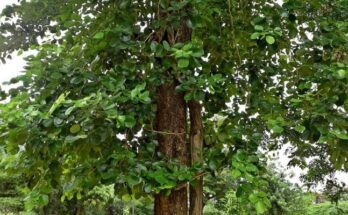|
Getting your Trinity Audio player ready...
|
About Mango Tree
The mango is connected with the traditions and spiritual ceremonies of India. The name mango, by which this fruit is known in English-speaking countries, is most likely derived from the Malayam manna, which the Portuguese adopted as manga when they came to Kerala in 1498 for the spice trade. In India, Hindus believe the mango tree to be the abode of gods. Many people use mango leaves to decorate their homes on special occasions and while conducting religious rituals such as Diwali, marriage, Navratri, and many other functions. Now let’s discuss more mango trees, the benefits of the mango tree, and types of mango trees.
Top 10 Types of Mango Trees
1. Alphonso Mango Tree
It is one of the best varieties of Mango in India in terms of sweetness and flavor. Alphonso mango is cultivated in the western part of India- the Maharashtra region of Ratnagiri, Raigad, Devgarh, and Konkan. Its weight is between 150 to 300 grams. You can identify this Mango by finding a tinge of red on the top of the fruit.
2. Badami Mango Tree
Another most consumed mango in India is Badami Mango. This Mango is famous for its size, flesh with juicy taste, and canary yellow color. It is also called Alphonso of Karnataka state. Andhra Pradesh and Karnataka states of India are the leading producers of it.
3. Chaunsa Mango Tree
In North, India Chaunsa is one of the sweetest mangoes. It has a bright yellow color with red blush. It is mainly produced in Mirpur Khas Sing in Punjab of Pakistan and in India popular in Bihar. Chaunsa mango was introduced by Sher Shah Suri during his reign in the sixteenth century and named after a town in Bihar.
4. Dasheri Mango Tree
In northern parts of India, Dasher mango is a delicious variety of Mango. Malihabad of Uttar Pradesh is the largest producer of Mango, along with other varieties of Mango such as Safeda, Lucknow, Chausa, and Jauhari.
5. Kesar Mango Tree
Kesar mangoes are also called Gir Kesar because it cultivated in the foothills of Girnar in the districts of Amreli and Junagadh. It was first variety cultivated by the Nawabs of Junagarh in 1931 and named Kesar in 1934. This Mango smells like Kesar.
6. Langra Mango Tree
Langra Mango is one of the most superior varieties of Mango in North India, and it is originated in Varanasi, Uttar Pradesh. The reason behind its name was that it was first cultivated in the farmlands of man without legs. They are available from the month of July to August. It is oval-shaped, and it is green in color.
7. Mulgoba Mango Tree
It is one of the best Mango grown in many parts of South India, especially in Tamil Nadu. It is a round mango that retains a green color with yellow shades. They are available in the month of May and June.
8. Neelam Mango Tree
It grows in any area of India, found in the month of June. These mangoes are mostly famous in Hyderabad.
9. Raspuri – Karnataka Tree
In India, the Raspuri Mango considers as the queen of Mangoes. They are oval in shape mango with juicy in texture and excellent flavor. It is produced and consumed in the old Mysuru of Karnataka. It arrives in the month of May and June. It tastes best in the form of Jam and yogurt.
10. Benishan Mango Tree
It is also known as Banganapalli mango and is one of the most common cultivars of Mango in the town of Banganapalle in Andhra Pradesh. Its weight is average 350-400 grams, and it is large size as compared to others mango.
6 Health Benefits of Mango
1. Improves Your Digestion: One of the leading causes of poor health is disorders of the digestive system. Mango is rich in fiber and polyphenols, so eating Mango can decrease constipation and inflammation of the bowels.
2. Helps in Gaining Weight: Many people are facing problems in gaining weight. Here Consuming Mango with milk can nourish the body and help in gaining weight, according to Ayurveda.
3. Boosts Your Immunity: Mango contains vitamin B6, vitamin C, zinc, and folate. All these help in strengthening the immune system and boosting immunity. If you stay healthy, you can live a longer life and protect your body from diseases and viruses.
4. It helps in Improving Eyesight: In this generation, even children are using mobile and laptop, and its light affects your eyes, which weaken the vision. In Mango, the presence of an abundance of carotenoids helps in improving eyesight.
5. Keeps Your Heart Healthy: Many research shows that a low level of selenium can increase the risk of heart problem. They are a good source of Vitamin B6, and both help keep your heart healthy. And also, having tea made with mango leaves helps in decreasing your blood pressure.
6. Keep your stomach healthy: For this, soak a few mango leaves in warm water and leave them overnight. In next morning consuming this water on an empty stomach helps in cleansing the stomach and flushing out toxins from your body.
Also Read: All About Lemon Tree With Their History, Benefits, Care, Fertilize, and Images
Conclusion
The mango tree produces the sweet mango fruit while absorbing carbon dioxide, producing oxygen, and promoting the livelihoods of thousands of workers. It really is the amazing mango tree. The mango has become a household fruit. Now, I hope we are able to provide you with sufficient and detailed information on Mango. So what are you waiting for, enjoy your summers with mangoes and relish your taste buds?



